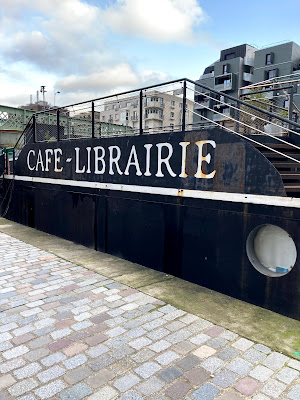The Ourcq canalisé supplies Paris with half its daily requirement of 380,000 cubic metres of water to flush out the sewers and street gutters and irrigate the vegetation in the city parks. It is the bigger but, culturally-speaking, poorer relation of the Canal St Martin which, cutting through the heart of Paris to the Seine, has always had a more glamorous profile (eg. Amélie, Piaf’s ‘les mômes de la cloche’ etc..) But I prefer the canal de l’Ourcq. I particularly prefer it at present because, as you walk away from the city, it offers you a fleeting glimpse of openness and imagined travel to distant places - both sorely lacking in the confinement – and it has its birds, its cormorants especially.
One chilly afternoon I walked to Villette on ‘my side’ of the canal. I was partly curious to see if the squat I had written about some years ago - wood smoke rising from behind its high fence - was still holding out. It isn’t. It has gone, swept away like most cobbled-together installations that poke out and disrupt the overarching urban narrative of anonymous conformity. What is left is another barren space with a cluster of pillars which are neither interesting nor useful.
Still, there is plenty to like on that stretch of the waterway. There are barges which would normally be open for concerts, cafes and books
and there is any amount of wacky, highly coloured mural art – tagging++. There is some interesting domestic architecture too and, tucked away in corners, more tents, because the homeless don’t just go away when their shelters are torn down.
Another day when I walk past the MK2 quai de Seine cinema there are five little blue tents neatly set up by the bike racks. The next time I’m there they’ve all gone. So it goes – the never-ending game of cat and mouse, the reckless, pointless binning in the name of ‘cleanliness’ of all that keeps the rain, frost and wind off people. I have written about that too. You can’t help but return to the same themes if the policies don’t change.
Are there any tourists at all, a friend asked, in these times of grounded aircraft and half-empty Eurostars? The answer is there are, although many fewer than normal. On New Year’s Day most of them seemed to have congregated up on the butte de Montmartre where the street artists were busy and the chestnut sellers and crêperies doing not bad trade as well.
Climbing the steps I came upon a woman in a glossy fur coat – visibly the product of dozens of small deaths. She was exercising a little dog which was clad in a coat with capuche (‘But he doesn’t like having the hood up’ – I quote) and boots on every foot.
Any big city will provide you with such sights but that afternoon the unmistakeable mix of ostentatious wealth and barely concealed loneliness in that dog-walker struck me more forcefully than usual. It was what I had witnessed ten minutes earlier in the église St Bernard that did it.
The church - the one I look out at from my sitting room window - is perhaps best known for its role in 1996 when the resident priest gave sanctuary to a group of illegal immigrants. After weeks of resistance by him and other activists the police stormed the church and removed the men, many of whom were on hunger-strike and very weak. Nothing lasting was achieved after that assault: no check on the gross misuse of force by the police (worse than ever 24 years later), nor a more humane response to the inhabitants of France’s ex-colonies and others seeking refuge.
This New Year’s Day it wasn’t shouts of defiance that I heard. It was singing. Inside the church was a congregation of between 40 and 50 people from the Democratic Republic of Congo who use the church as their place of worship. The priest was preaching and they were singing in Lingala, the main indigenous language of the DRC. The church was full to bursting with the sound. It was so free, so joyous it made me wish they could take their upswelling voices, the intoxicating beat of their music, out onto the street to send cascades of praise spiralling up and paint the grey skies over Paris in golds and reds and blues.
Bonne année et bonne santé!








